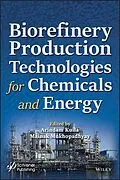This book covers almost all of the diverse aspects of utilizing lignocellulosic biomass for valuable biorefinery product development of chemicals, alternative fuels and energy.
The world has shifted towards sustainable development for the generation of energy and industrially valuable chemicals. Biorefinery plays an important role in the integration of conversion process with high-end equipment facilities for the generation of energy, fuels and chemicals.
The book is divided into four parts. The first part, "Basic Principles of Biorefinery," covers the concept of biorefinery, its application in industrial bioprocessing, the utilization of biomass for biorefinery application, and its future prospects and economic performance. The second part, "Biorefinery for Production of Chemicals," covers the production of bioactive compounds, gallic acid, C4, C5, and C6 compounds, etc., from a variety of substrates. The third part, "Biorefinery for Production of Alternative Fuel and Energy," covers sustainable production of bioethanol, biodiesel, and biogas from different types of substrates. The last part of this book discusses sequential utilization of wheat straw, material balance, and biorefinery approach.
The approaches presented in this book will help readers/users from different areas like process engineering and biochemistry to plan integrated and inventive methods to trim down the expenditure of the industrial manufacture process to accomplish cost-effective feasible products in biorefinery.
Autorentext
Arindam Kuila is an assistant professor at the Department of Bioscience & Biotechnology, Banasthali Vidyapith, Rajasthan, India. Previously, he worked as a research associate at Hindustan Petroleum Green R&D Centre, Bangalore, India. He gained his PhD from the Agricultural & Food Engineering Department, Indian Institute of Technology Kharagpur, India in 2013 in the area of lignocellulosic biofuel production. He has co-authored 18 peer-reviewed research papers, 7 review papers, edited 4 books, 8 book chapters and filled 5 patents.
Mainak Mukhopadhyay is an assistant professor at the Department of Biotechnology, JIS University, Kolkata. Previously, he worked as a research fellow at ONGC Energy Centre, Delhi, India. He gained his PhD from the Agricultural & Food Engineering Department, Indian Institute of Technology Kharagpur, India in 2014. His PhD research was focused on degradation of lignin present in lignocellulosic biomass for the higher production of second-generation bioethanol. His research interests also consist of enzymology, nanobiotechnology, biomass conversion technology. He was awarded a Petrotech Research Fellowship in 2008. In 2016 he was awarded the Early Career Research Award from DST-SERB. He has co-authored 10 peer-reviewed papers, 3 review papers, 10 book chapters and filled 2 patents.
Inhalt
Preface xv
Part 1: Biorefinery Basic Principles 1
1 Principles of Sustainable Biorefinery 3
Samakshi Verma and Arindam Kuila
1.1 Introduction 3
1.2 Biorefinery 5
1.3 Conversion Technologies of Biorefineries 6
1.4 Some Outlooks Toward Biorefinery Technologies 7
1.5 Principles of Sustainable Biorefineries 9
1.6 Advantages of Biorefineries 10
1.7 Classification of Biorefineries 10
1.8 Conclusion 12
References 12
2 Sustainable Biorefinery Concept for Industrial Bioprocessing 15
Mohd Asyraf Kassim, Tan Kean Meng, Noor Aziah Serri, Siti Baidurah Yusoff, Nur Artikah Muhammad Shahrin, Khok Yong Seng, Mohamad Hafizi Abu Bakar and Lee Chee Keong
2.1 Sustainable Industrial Bioprocess 15
2.2 Biorefinery 16
2.2.1 Starch Biorefinery 18
2.2.2 Lignocellulosic Biorefinery 19
2.3 Microalgal Biorefinery 22
2.3.1 Upstream Processing 23
2.3.2 Downstream Processing 24
2.3.2.1 Lipid-Extracted Microalgae 24
2.4 Value Added Products 27
2.4.1 Biofuel 27
2.4.1.1 Bioethanol 30
2.4.1.2 Biobutanol 31
2.4.1.3 Biodiesel 34
2.4.1.4 Short Alkane 36
2.4.2 Polyhydroxyalkanoates (PHA) 36
2.4.3 Bioactive Compounds From Food Waste Residues 39
2.5 Novel Immobilize Carrier From Biowaste 42
2.5.1 Waste Cassava Tuber Fiber 42
2.5.2 Corn Silk 43
2.5.3 Sweet Sorghum Bagasse 43
2.5.4 Coconut Shell Activated Carbon 44
2.5.5 Sugar Beet Pulp 44
2.5.6 Eggshells 45
2.6 Conclusion 45
References 46
3 Biomass Resources for Biorefinery Application 55
Varsha Upadhayay, Ritika Joshi and Arindam Kuila
3.1 Introduction 55
3.2 Concept of Biorefinery 56
3.3 Biomass Feedstocks 57
3.3.1 Types of Biomass Feedstocks 57
3.3.1.1 Biomass of Sugar Industry 57
3.3.1.2 Biomass Waste 58
3.3.1.3 Sugar and Starch Biomass 59
3.3.1.4 Algal Biomass 59
3.3.1.5 Lignocelluloses Feedstock 59
3.3.1.6 Oil Crops for Biodiesel 60
3.4 Processes 60
3.4.1 Thermo Chemical Processes 62
3.4.2 Biochemical Processes 63
3.4.3 Biobased Products and the Biorefinery Concept 64
3.5 Conclusions 64
References 65
4 Evaluation of the Refinery Efficiency and Indicators for Sustainability and Economic Performance 67
Rituparna Saha and Mainak Mukhopadhyay
4.1 Introduction 67
4.2 Biofuels and Biorefineries: Sustainability Development and Economic Performance 69
4.3 Future Developments Required for Building a Sustainable Biorefinery System 72
4.4 Conclusion 72
References 73
5 Biorefinery: A Future Key of Potential Energy 77
Anirudha Paul, Sampad Ghosh, Saptarshi Konar and Anirban Ray
5.1 Introduction 77
5.2 Biorefinery: Definitions and Descriptions 78
5.3 Modus Operandi of Different Biorefineries 79
5.3.1 Thermochemical Processing 79
5.3.2 Mechanical Processing 79
5.3.3 Biochemical Processing 79
5.3.4 Chemical Processing 79
5.4 Types of Biorefineries 80
5.4.1 Lignocellulose Feedstock Biorefinery 80
5.4.2 Syngas Platform Biorefinery 81
5.4.3 Marine Biorefinery 81
5.4.4 Oleochemical Biorefinery 81
5.4.5 Green Biorefinery 81
5.4.6 Whole Crop Biorefinery 82
5.5 Some Biorefinery Industries 82
5.5.1 European Biorefinery Companies 82
5.5.2 Biorefinery Companies in USA 82
5.5.3 Biorefinery Companies in Asia 83
5.6 Conclusion and Future of Biorefinery 83
References 84
Part 2: Biorefinery for Production of Chemical...
